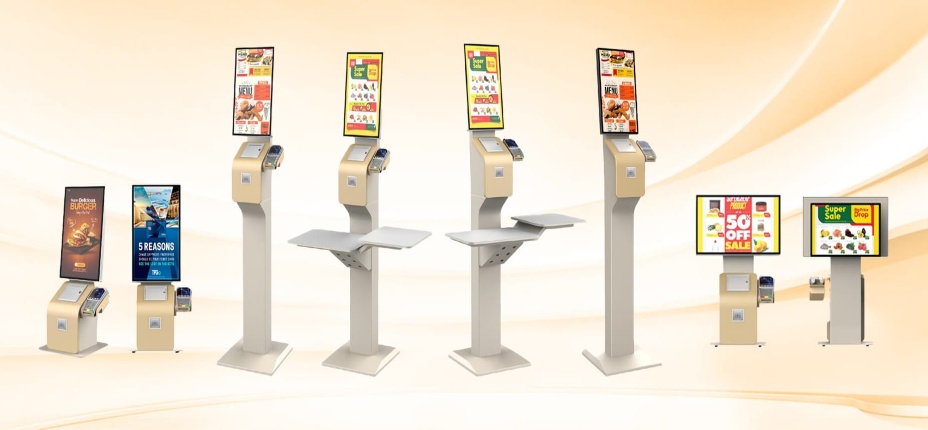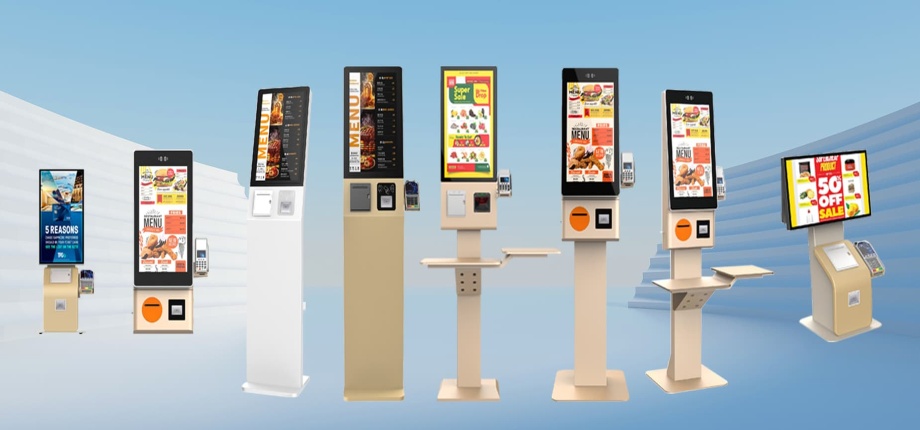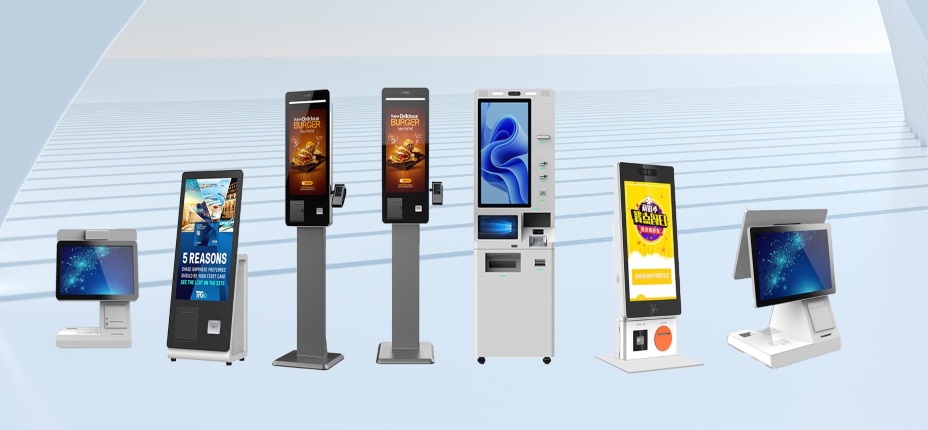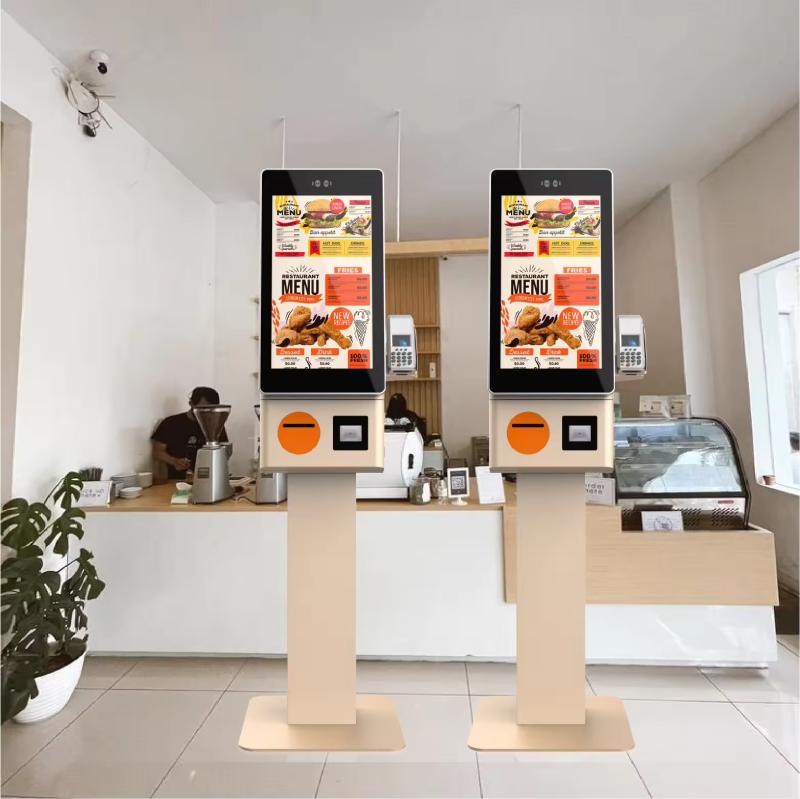





Self ordering kiosk is an interactive, self-service kiosk machine that allows customers to browse menus, customize orders, and make payments independently in restaurants or fast-food outlets. It streamlines the ordering process, reduces wait times, and enhances accuracy by enabling customers to control their orders directly, improving overall dining efficiency and satisfaction.
Welcome to our Self Ordering Kiosk page. This is our most popular and competitive kiosk machine from Lean Kiosk Systems. As an experienced kiosk manufacturer, we will introduce our self-ordering kiosk in detail from multiple perspectives, including its functions, applications, designs, customized styles, sizes, and price ranges. Please read carefully to learn more about this product. We also encourage you to ask questions and discuss with us to enhance our self-ordering kiosk business together.
Self ordering kiosk outline navigation
Self ordering kiosk definition
Features of self ordering kioskComponents and specifications of a self ordering kioskTypes and sizes of self ordering kioskApplications of self ordering kioskSelf ordering kiosk price
Advantags and benefits of self ordering kioskCost and ROI of self ordering kioskCustomization options of self ordering kioskSelf ordering kiosk installation and usage guidePurchase advice of self ordering kioskTechnology support and services of self ordering kioskFAQS about self ordering kiosk |
|
What is a Self Ordering Kiosk?A self ordering kiosk is a digital, interactive station that allows customers to browse menus, customize their orders, and make payments without needing assistance from staff. Commonly found in restaurants, fast-food outlets, and cafes, these kiosks streamline the ordering process, reduce wait times, and improve order accuracy. They enhance the customer experience by offering a convenient, user-friendly interface that empowers customers to take control of their orders, leading to faster service and greater satisfaction. | Self-Ordering Kiosk MeaningA self ordering kiosk refers to a touch-screen device that enables customers to independently select, customize, and pay for their orders in a variety of settings, such as restaurants and retail outlets. These kiosks are designed to improve operational efficiency by reducing the reliance on cashier staff, minimizing errors, and speeding up the ordering process. They also provide businesses with valuable data on customer preferences, helping to tailor offerings and enhance service quality. |
| Component | Description | Specifications |
|---|---|---|
| Touchscreen Display | An interactive display that allows users to navigate menus, select items, and customize orders. | Size: 15" to 32" diagonal Resolution: 1080p Full HD or higher Type: Capacitive or resistive touchscreen |
| Payment Terminal | Integrated device for processing various payment methods, including cards, mobile payments, and contactless transactions. | Types: EMV chip, magnetic stripe, NFC/contactless Security: PCI-DSS compliant Additional Features: Receipt printer |
| Thermal Printer | A printer that produces receipts for customers after order placement or payment. | Paper Width: 58mm or 80mm Print Speed: 200mm/sec Resolution: 203 dpi |
| Processor | The central processing unit (CPU) that powers the kiosk, enabling smooth operation and quick response times. | Type: Intel i3, i5, or higher RAM: 4GB to 8GB Storage: SSD 128GB or higher |
| Operating System | The software platform that manages the kiosk's hardware and application software. | Common Options: Windows, Android, Linux Version: Latest stable release |
| Enclosure | The outer casing that protects the internal components and provides a sleek, professional appearance. | Material: Steel or aluminum Finish: Powder-coated or brushed metal Mounting: Floor-standing or wall-mounted |
| Barcode/QR Code Scanner | A scanner that reads barcodes or QR codes for promotions, loyalty programs, or order retrievals. | Type: 1D/2D barcode scanner Scan Speed: 300 scans/sec Interface: USB or serial |
| Speakers | Integrated audio output for providing sound notifications or promotional audio. | Output: 2W to 5W Type: Stereo speakers Audio Jack: 3.5mm or integrated |
| Network Connectivity | Enables the kiosk to connect to the internet or local network for processing transactions and syncing data. | Options: Ethernet, Wi-Fi, 4G/LTE Security: WPA2, VPN support Ports: RJ45, USB |
| Camera (optional) | A camera used for customer identification, facial recognition, or video calls for remote assistance. | Resolution: 720p to 1080p Lens: Wide-angle Features: Autofocus, low-light capability |

Features of a Self-Ordering Kiosk
| Applications of a Self-Ordering Kiosk
|
| Type | Description | Typical Sizes (Height x Width x Depth) |
|---|---|---|
| Freestanding Kiosk | A standalone unit designed to be placed on the floor in high-traffic areas, offering full accessibility. | Standard: 60" x 20" x 18" Large: 72" x 24" x 20" Compact: 50" x 18" x 16" |
| Countertop Kiosk | A smaller kiosk intended for placement on countertops or tables, ideal for limited space environments. | Standard: 24" x 18" x 12" Compact: 18" x 12" x 10" Large: 30" x 20" x 14" |
| Wall-Mounted Kiosk | A space-saving option that is mounted on a wall, typically used in narrow or crowded areas. | Standard: 48" x 20" x 6" Compact: 36" x 16" x 5" Large: 60" x 24" x 8" |
| Outdoor Kiosk | A rugged, weather-resistant unit designed for outdoor use, with enhanced durability and visibility. | Standard: 65" x 24" x 22" Large: 78" x 28" x 24" Compact: 55" x 20" x 18" |
| Dual-Sided Kiosk | A freestanding kiosk with screens on both sides, allowing multiple users to interact simultaneously. | Standard: 60" x 24" x 20" Large: 72" x 28" x 22" Compact: 50" x 22" x 18" |
| Tablet-Based Kiosk | A smaller, portable option that utilizes a tablet as the main interface, often used for flexibility. | Standard: 10" x 7" x 6" (Tablet Size) Large: 12" x 8" x 7" Compact: 8" x 6" x 5" (Tablet Size) |
| Self-Checkout Kiosk | A large kiosk designed for customer self-checkout in retail environments, typically equipped with a scanner. | Standard: 70" x 28" x 24" Large: 80" x 32" x 26" Compact: 60" x 24" x 20" |

| Model/Type | Region | Style/Design | Price Range (USD) | Additional Factors |
| Freestanding Kiosk | North America | Standard Design | $3,500 - $7,000 | Custom branding, advanced features, and higher durability may increase the cost. |
| Europe | Standard Design | $3,000 - $6,500 | ||
| Asia | Basic Design | $2,500 - $5,500 | ||
| Countertop Kiosk | North America | Compact Design | $1,500 - $3,500 | Limited customization and smaller size typically lead to lower prices. |
| Europe | Standard Design | $1,200 - $3,000 | ||
| Asia | Basic Design | $1,000 - $2,800 | ||
| Wall-Mounted Kiosk | North America | Sleek, Space-Saving Design | $2,000 - $4,500 | Installation costs and location may affect the final price. |
| Europe | Compact Design | $1,800 - $4,000 | ||
| Asia | Standard Design | $1,500 - $3,800 | ||
| Outdoor Kiosk | North America | Weather-Resistant Design | $5,000 - $10,000 | High durability and weatherproofing increase the cost. |
| Europe | Durable, High-Visibility Design | $4,500 - $9,000 | ||
| Asia | Standard Weatherproof Design | $4,000 - $8,000 | ||
| Dual-Sided Kiosk | North America | Large, Multi-User Design | $7,000 - $12,000 | Additional screens and features for multiple users drive up costs. |
| Europe | Standard, Dual-Screen Design | $6,500 - $11,000 | ||
| Asia | Compact Dual-Screen Design | $6,000 - $10,500 | ||
| Tablet-Based Kiosk | North America | Portable, Simple Design | $800 - $2,000 | Lower cost due to smaller size and fewer components. |
| Europe | Basic, Tablet Integration | $700 - $1,800 | ||
| Asia | Standard Tablet Design | $600 - $1,500 | ||
| Self-Checkout Kiosk | North America | Full-Feature, Large Design | $6,000 - $12,000 | Integration with payment systems and large display options increase prices. |
| Europe | Standard Retail Design | $5,500 - $11,000 | ||
| Asia | Compact Retail Design | $5,000 - $10,000 |
|
|
Advantages of Self-Ordering Kiosks:
| Benefits of Self-Ordering Kiosks:
|

The cost of implementing self-ordering kiosks can vary significantly depending on factors such as customization, technology integration, and installation complexity. Typically, a single self-ordering kiosk ranges from $3,000 to $10,000, with more advanced models reaching higher price points. Additional costs may include software licensing, maintenance, and potential installation fees. Despite the upfront investment, the return on investment (ROI) can be substantial. Self-ordering kiosks can lead to labor cost savings by reducing the need for cashiers and order takers. They also enhance order accuracy, which minimizes waste and reduces costs associated with order corrections. Furthermore, kiosks often increase average order value through effective upselling and cross-selling, contributing to higher revenue. Over time, the combination of reduced operational costs and increased sales can result in a quick ROI, often within a year, making self-ordering kiosks a financially attractive investment for businesses aiming to improve efficiency and profitability.
Branding and Design: Customize the kiosk’s exterior with your company’s logo, colors, and branding elements to create a cohesive and visually appealing look that aligns with your brand identity.
Screen Size and Resolution: Choose from various screen sizes and resolutions to match the specific needs of your business, whether you require a compact display for smaller spaces or a large, high-resolution screen for enhanced visibility.
Payment Integration: Customize the payment options available, including support for credit/debit cards, mobile payments, and even contactless solutions like Apple Pay or Google Wallet, catering to customer preferences.
Software Interface: Tailor the user interface and software features to match your business requirements, including custom menus, language options, and specific functionalities like order tracking or loyalty program integration.
Hardware Add-ons: Enhance the kiosk with additional hardware options such as barcode scanners, receipt printers, or cameras for added functionality, depending on the specific use case.
Accessibility Features: Incorporate accessibility options such as adjustable screen heights, voice-guided navigation, and braille keypads to ensure the kiosk is usable by all customers, including those with disabilities.
Security Enhancements: Customize security features, including secure payment processing modules, tamper-proof casings, and data encryption, to protect both the kiosk and customer information.
As a professional self-ordering kiosk manufacturer, we recommend following these detailed steps for proper installation:
1. Site Preparation:
| 2. Unboxing and Inspection:
|
3. Assembly:
| 4. Power and Network Setup:
|
Software Setup:
| Final Adjustments and Calibration:
|
Training: Provide training for staff on how to assist customers with the kiosk and handle basic troubleshooting.
Monitoring: Monitor the kiosk’s performance during the first few days of operation to ensure everything is functioning smoothly.
Support Contact: Ensure that support contact information is readily available for any issues that arise.

Here’s how customers and staff can effectively use a self-ordering kiosk:
1. Start the Order:
| 2. Customizing Orders:
|
3. Review and Modify Orders:
| 4. Payment Process:
|
5. Order Confirmation:
| 6. Customer Assistance:
|
Daily Cleaning: Regularly clean the screen and kiosk surfaces to maintain hygiene and functionality.
System Updates: Ensure the kiosk software is up-to-date with the latest features and security patches. Periodically check for updates from the manufacturer.
Technical Support: For any technical issues, contact the kiosk manufacturer’s support team, who can guide you through troubleshooting or arrange for maintenance.
Define Your Needs: Clearly identify the specific needs of your business, including the types of products or services you offer, the volume of transactions, and the customer demographic. This will help you choose a kiosk that meets your operational requirements.
Evaluate Software Compatibility: Ensure the kiosk’s software is compatible with your existing systems, such as POS, inventory management, and payment processing. Compatibility is crucial for seamless integration and efficient operations.
Consider Customization Options: Look for kiosks that offer customization in design, branding, and functionality. Customizing the kiosk to reflect your brand and meet specific business needs can enhance customer engagement and satisfaction.
Check Payment Flexibility: Verify that the kiosk supports multiple payment methods, including credit/debit cards, mobile payments, and cash. Offering diverse payment options can cater to a wider range of customers.
Assess Durability and Quality: Invest in a kiosk built with durable materials and components, especially if it will be used in high-traffic or harsh environments. A well-built kiosk will have a longer lifespan and require less maintenance.
Review Vendor Support: Choose a reputable vendor that offers reliable after-sale support, including installation assistance, software updates, and technical maintenance. Good support is essential for minimizing downtime and addressing any issues promptly.
Analyze Total Cost of Ownership: Consider the full cost of ownership, including initial purchase price, installation, maintenance, and potential upgrades. Evaluate the ROI to ensure the investment aligns with your business’s long-term financial goals.
Kiosk manufacturer provide all different kinds of self ordering kiosk customize and design, if you are want to know and buy our self ordering kiosk products, you can click self ordering kiosk for sale to learn more!
| Technology Support | After-Sales Services |
|---|---|
| Software Updates | Regular updates to enhance functionality, security, and compatibility with evolving technologies. |
| Remote Diagnostics & Support | Remote access for troubleshooting, diagnostics, and resolving software or hardware issues without on-site visits. |
| 24/7 Technical Support | Round-the-clock support via phone, email, or chat, offering immediate assistance for any technical problems. |
| Installation & Setup | Professional installation services, including site preparation, kiosk assembly, and initial configuration. |
| Training & Documentation | Comprehensive training programs and detailed user manuals to help staff operate and maintain the kiosk effectively. |
| Customization & Integration | Tailored software and hardware solutions to meet specific business needs, ensuring smooth integration with existing systems. |
| Monitoring & Analytics | Real-time monitoring and analytics to track kiosk performance, user interactions, and system health. |
A self-ordering kiosk is an interactive touchscreen terminal that allows customers to browse a menu, customize orders, and complete transactions without the need for assistance from a cashier. These kiosks are commonly used in restaurants, cafes, and fast-food chains to streamline the ordering process.
Self-ordering kiosks can reduce wait times, increase order accuracy, and improve customer satisfaction. They also allow for upselling opportunities through automated prompts, leading to higher average order values and increased sales.
Self-ordering kiosks typically accept various payment methods, including credit and debit cards, mobile payments (e.g., Apple Pay, Google Wallet), and sometimes cash. The range of payment options can be customized based on the business’s needs.
Yes, the menu displayed on a self-ordering kiosk can be fully customized to match your brand’s offerings. You can easily update the menu items, prices, and promotions through the kiosk’s backend management system.
Regular maintenance includes cleaning the touchscreen, updating software, checking the hardware components, and ensuring the payment systems are functioning correctly. Many kiosks come with remote monitoring and diagnostics to simplify maintenance.
Most modern self-ordering kiosks are designed to integrate seamlessly with existing POS systems. This integration allows for smooth order processing, real-time inventory updates, and consolidated reporting, making it easier to manage both in-person and kiosk orders.
More faqs you can click self ordering kiosks faqs
A self-ordering kiosk is an interactive terminal that enables customers to place and customize orders independently. It helps streamline the ordering process by allowing users to browse menus, select items, and make payments without cashier assistance. This enhances customer satisfaction through reduced wait times and increased order accuracy. Key benefits include improved efficiency, higher average order values due to upselling opportunities, and reduced labor costs. Investing in self-ordering kiosks is often worthwhile, as they offer a quick return on investment through increased sales and operational savings. When purchasing, ensure the kiosk meets your business needs with customizable features, supports diverse payment methods, and integrates smoothly with your existing POS system. Look for a vendor that provides robust technical support and after-sales services to maximize your investment.
Address: No. 99-15, Fuan intelligent manufacturing Industrial Park, Dayang Road, Fuhai Street, Baoan District, Shenzhen, China